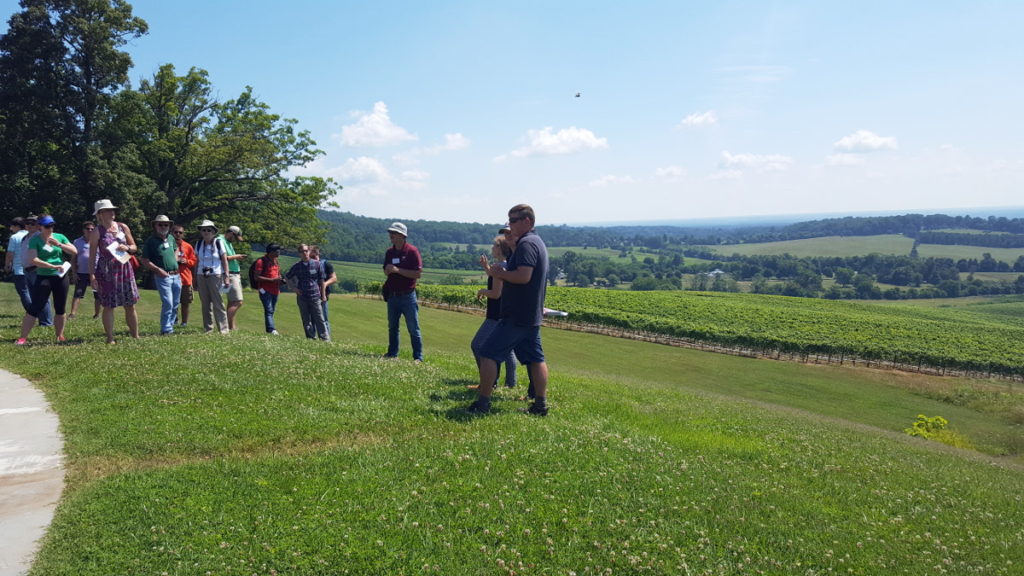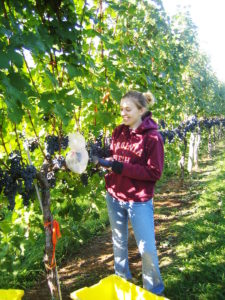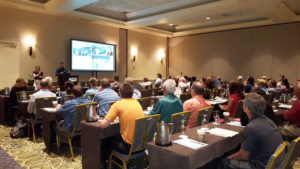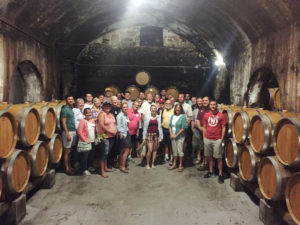
Photo by: Denise M. Gardner
Last week, I introduced a question that was posed to me during a previous Darn Good Winemakers session. I thought the question was so thought provoking that it required pause and attention as a blog post.
Thus, today, we’re diving into part 2 of our 3 part blog series surrounding the question on cluster zone leaf removal. For access to part 1, click on the bulleted link below. Otherwise, stay tuned as we cover the following:
- Why I don’t make viticulture recommendations as an enologist.
- How to separate research findings and commercial application.
- Finally, getting three viticulture expert opinions on cluster zone leaf removal techniques, and closing winemaker thoughts.
Hoping you’ll join us for all three posts!
Where do viticulture or enology principles and recommendations come from?
In my last blog post, I explained my opinion on why I don’t think I’m the best person to ask for vineyard-based advice or how the vineyard ultimately affects the wine.
That being said, I do have an opinion that grape growing decisions should be based on site, the cultivars grown on site, and experience pertaining to the site with the support from viticulture management principals and scientific research. In fact, this is also how I view winemaking-based (enology) decisions, as well.
Which leads me to the second topic: where do viticulture and enology principles or recommendations come from?
The answer: scientific research, of course!
When a research scientist looks at any study, there is a lot of behind-the-scenes work that takes place in designing the study. These details are often stated in peer reviewed scientific journal publications. The details, however, can be further lost as the study gets summarized in industry trade magazines, through press releases, and by word-of-mouth discussion.
Researchers that work in applied scientific fields (e.g., agriculture) know that there are A LOT of variables that convolute research. Good viticulture and enology research often requires collaboration with a statistician. For vineyard-related research, the statistician often outlines sampling of specific vines, even within a specific site, in order to help reduce some of that variation associated with the natural world. It is only after a design is created that researchers work to compare a treatment, side-by-side, over the course of three or more years for most viticulture research.

Photo from: Denise M. Gardner
Having access to side-by-side comparisons in consecutive vintage years is a slow process. It can take years to determine trends and develop clear recommendations for growers or winemakers based on studies’ results. In the case of cluster zone leaf removal, researchers aim to evaluate extreme comparisons (i.e., no leaf removal versus large band widths or high numbers of leaves removed) to test the repeatability of the leaf removal technique. Essentially they are asking the question: what changes (if any) did the treatment cause to the fruit? As, Dr. Cain Hickey, Assistant Professor of Viticulture at the University of Georgia put it, “I may remove as many as eight leaves in some of my experiments, but this is to test extremes. I would never assume that anyone would apply those treatments commercially.”
These scientifically-based findings are the backbone of recommendations that are then used for growing recommendations, or, in the case of wine, winemaking recommendations. While results and conclusions are published through peer reviewed journals, most growers or industry members end up receiving a condensed version of these results through university Extension communications.
Reading scientific research
Mitigating scientific research can be challenging to the untrained individual. Over the years, I’ve enjoyed The Academic Wino’s blog posts as she takes the time to read a study and translate as much as of the study as possible to a lay audience. Furthermore, I make a devoted effort to try to integrate research results into my suggestions for clients and discuss the science behind winemaking through my blog communications, here.
In my opinion, most of the research completed by academic institutions is quite thorough. Although some of the research topics may stay consistent over time, this leaves the industry with documented changes through that time as well. Most members of this audience can stay informed with new research by staying in touch with the American Society of Enology and Viticulture – Eastern Section (ASEV-ES), a chapter of the ASEV national organization. While professors and researchers may opt to publish in alternative scientific journals, ASEV manages two peer reviewed journals (The American Journal of Enology and Viticulture, or AJEV, and Catalyst) for research publication. The ASEV-ES chapter, specifically, moves their conference throughout the U.S. and Canada each year to help improve research symposium accessibility to a number of wine industries throughout the U.S.

Photo by: Denise M. Gardner
I’ve actually had the pleasure of working in research through multiple perspectives: academically, through a private company, and with industry members. For example, with some of my colleagues and a student I mentored, I previously published an applied study on co-inoculation within AJEV. We did this project in tandem with two winery owners in which we designed a second study to mimic our research treatments in the cellar, but under practical conditions (i.e., the treatments would be easy for them to manage and they could use the wine commercially). While the results from the industry were not published in the peer reviewed paper, we did use their data during Extension presentations and discussions to show applicability in the cellar at a commercial level.
To supplement this thorough research forum, today, many private companies, trade organizations, and industry members also conduct scientific research. Some research is prestigious enough for peer reviewed publication. Other research may lack some scientific design rigor, but still contribute to the conversation. You can often find those research findings in industry trade magazines or through self-publication.
Why research takes so long… and why that is important

Photo from: Denise M. Gardner
In the case of viticulture research, researchers evaluate vine treatments and how vines are affected over the course of several years because there is so much variation in annual weather. Remember, grapes are only produced one time of year, and thus, treatment application and data collection can only take place one time per year. To evaluate the efficacy of a treatment, several years of data need collected to account for seasonal variation. While this type of research takes a long time to evaluate, the findings often provide validation to make good recommendations to growers.
This means that ongoing research is not only expected, but that it is also important.
Having continuous research is important because, as many of us know, the science changes and, thus, grower recommendations change over time. There are a lot of things growers did in the 1980’s that are no longer recommended or commercially practiced.
Science advances as society, culture, the environment and technology changes. The climate is changing and affects growing conditions each year. New pests, diseases, and environmental challenges arise that impact the way we grow grapes or make wine. The slow, ongoing research helps us adapt to those changes by continuously testing applications over time.
However, this is a rather slow approach for a commercial operation that needs to operate in real time. Thus, thorough research can lose its appeal over time to commercial operations. In some instances, the research may become undervalued as time progresses or as results end up not being overly exciting.
The integration of research results in a commercial operation
Whether we’re talking about grape growing or winemaking practices, many of us that keep up with Extension literature quickly adopt new practices and expect it to all just work, right?
Well… no. First, adoption of new practices and recommendations is often a slow process. From my perspective, I think I have been telling people to measure YAN for about 10 years now. I would wage that many of you reading this article still aren’t measuring YAN. Within that 10 years of time, however, fermentation nutrient management recommendations have changed. Recommendations I made in 2009 are not exactly the same as recommendations I make today. If you haven’t noticed these changes, now is a good time to ask yourself if you have been aware of fermentation nutrient management changes.
Without research, grape growers and winemakers may be left with outdated processes, applications, and with (what I like to call) production myths (aka, broad statements said without any real evidence to support that idea or observation). To put the importance simply: imagine going out to your vineyard and seeing a disease affecting all of your vines. Maybe you know what the disease is, maybe you don’t. Without evolving scientific research, the recommendation to handle that disease would probably be: here are 10 sprays. See which one works.
Instead, research allows us to give growers recommended sprays, application rates, and interval windows for application.
Recipe winemaking… and avoiding the “this always works” statement.
Most of my clients probably know that I very rarely make a winemaking recommendation with the following statement, “this always works.”
Why do I avoid that phrase?
Well, because food science, including enology, is based on complex (complicated!) scientific trends. We tend to make recommendations that usually work. Unfortunately, scientists do not often speak in absolutes because understandings are based on probabilities. Very rarely can scientists make a recommendation that always works, as there may be a possible variable that can cause unforeseen results. This is why you’ll always hear me say, “Make sure you do bench trials first,” whenever I’m discussing a wine treatment.
I believe the same is true with viticultural recommendations. Actually, I think this is true with science in general, which is what makes it such a difficult field to communicate to the non-scientific community. Scientists tend to avoid absolutes for this very reason.
Grape grower or winemaker observations and trials
The other large difference between a commercial operation adapting a new practice/technique is the fact that very rarely are commercial operations comparing side-by-side treatments in the same vintage year. And, if they are, they are usually testing those side-by-side treatments without the rigor associated with peer reviewed studies (e.g., having adequate replications, integration of randomization, etc.). The lack of those details makes it difficult to say some other variable did not contribute to their observations for that year even when a treatment is applied.
Many times when I hear winemakers give me a conclusion on something they have “observed,” I find they applied a treatment one vintage year, received a result that wasn’t consistent with what they thought should happen, and thus, completely discredit the science that was originally published. Without comparing a treatment over multiple vintage years, varieties, and with side-by-side comparisons, it’s easy to lose sight of the original findings. I’m not saying that winemaker was wrong. And truly, I believe testing the science’s applicability is important. What I am saying is this: we need to be better aware of our expectations based on scientific trends and recommendations, while also aware of the limitations in our own individual findings or experiences. If you’re uncertain, talk to a scientist or join our Darn Good Winemakers group in which I can help you. We talk about science a lot through that network with my goal to help break winemaking habits that have become easy or routine.
In the specific case of cluster zone leaf removal, the observations that were made by winemakers in the original question were that they found cluster zone leaf removal caused more “baked” or “cooked” flavors. Even more specific were the descriptors: baked apple and cooked cabbage.
From a winemaking perspective, there are a number of Chardonnay cultivars available to growers that get made into wine. There is one winery I work with in Pennsylvania that has a mixed block of Chardonnay cultivars (a number of different Chardonnay cultivars mixed together within one vineyard block). From him, I have learned that even when the same vineyard management techniques are applied to ALL of those Chardonnay vines, he ends up with grapes that have riper Chardonnay fruit aromas and others that lack the riper flavors in any given vintage. Remember, Chardonnay varietal flavors can include a whole host of descriptors: citrus, lemon, lime, apple, floral, orange blossom, tropical fruits, pear, peach, apricot, pineapple, and kiwi just to name a few.
Is it possible that baked apple aroma developed as a result of the vineyard treatment? Sure. But it could also result based on how that Chardonnay cultivar ripens. Is this aromatic descriptor bad? I can’t necessarily conclude that.
Furthermore, I found a bit of “danger” in those statements. The danger being that winemakers associated “cooked cabbage” aromatics with a vineyard treatment.
I don’t associate “cooked cabbage” as a contribution from the vineyard and it bothers me when reduced aromatics get thrown into the mix as a grower’s problem. The “cooked cabbage” descriptor to me says: winemaking problem.
There is scientific evidence about sulfur sprays leading to higher incidences of hydrogen sulfide and reduced aromas. However, sulfur sprays were not included as variable associated within the question asked. In most of my experiences, winemakers that end up with a “cooked cabbage” aroma are doing one of a few things:
- Conducting native fermentations that are not well managed,
- Not measuring their nitrogen (YAN), and hence, not making specific nitrogen adjustments specific to their fermentations, or
- Have a reduction issue in one or more wine processes.
I know we all like to say, “Wine is made in the vineyard,” but it’s not. The vineyard cannot literally make wine. The winemaker has a stamp on the quality of the wine. Having spent decades of my life focused on wine production, I can guarantee you that crappy wine can get made from great grapes and from poor quality grapes. Winemaking decisions have power.
Next week, we’ll finally address cluster zone leaf removal
For the grand finale, I talked to three viticulture experts – 2 professors and one consultant – on cluster zone leaf removal techniques. We’ll finally get a chance to hear their opinion on the topic and get some real answers to the question asked last week.
